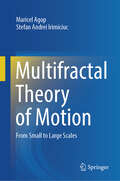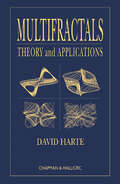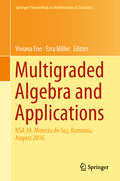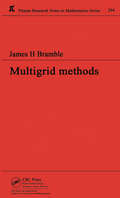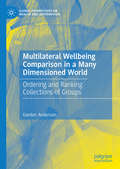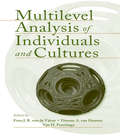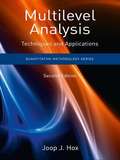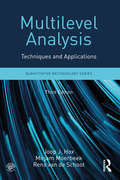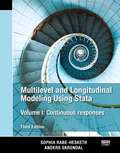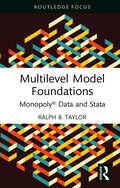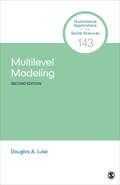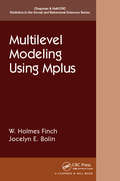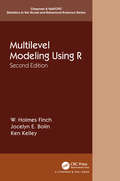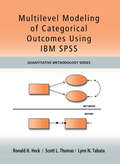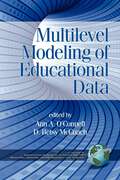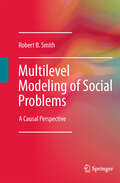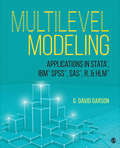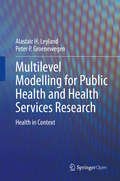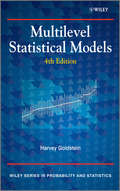- Table View
- List View
Multifractal Theory of Motion: From Small to Large Scales
by Maricel Agop Stefan Andrei IrimiciucThis book aims to present the topic of nonlinear and chaotic dynamics in a manner that is useful and beneficial to students and young researchers from various domains such as physics, mathematics, biology, or even medicine. A very important aspect of that topic is that the constraints of determinism do not imply a regular behavior or do not rely on predictability in describing the dynamics of natural systems. Exploring the evolution of natural systems has a great impact nowadays on a wide range of scientific domains. The dynamics of populations, cardiac fibrillation, communication systems, fluid flow, and atmospheric systems are just a few topics in which nonlinearity and chaos are a regular manifestation. This leads to the idea that it is necessary to find universal laws that govern these dynamics. The aforementioned variety in scientific topics is also sustained by an exponential interest in recent decades from readers in the scientific community and the non-scientific one as well. The book is devoted to the nonlinear and chaotic dynamics topic, a domain that is both trans- and multi-disciplinary and has been the focus of the scientific community in past decades.
Multifractals: Theory and Applications
by David HarteAlthough multifractals are rooted in probability, much of the related literature comes from the physics and mathematics arena. Multifractals: Theory and Applications pulls together ideas from both these areas using a language that makes them accessible and useful to statistical scientists. It provides a framework, in particular, for the evaluation
Multigraded Algebra and Applications: NSA 24, Moieciu de Sus, Romania, Аugust 2016 (Springer Proceedings in Mathematics & Statistics #238)
by Viviana Ene Ezra MillerThis volume contains research papers and surveys reflecting the topics discussed at the EMS Summer School on Multigraded Algebra and Applications held in Romania in August 2016. The school, which served as the 24th National School on Algebra, presented the main research directions of combinatorial commutative algebra with a strong focus on its applications in combinatorics, statistics, and biology. Recent progress in the field has led to new insights and suggested algebraic techniques for solving real-world data analysis problems. The summer school and resulting proceedings volume have raised numerous novel questions and encouraged a more interdisciplinary approach for young researchers when considering problems in pure and applied mathematical research.Featured topics in this volume include toric rings, binomial edge ideals, Betti numbers for numerical semigroup rings, and Waldschmidt constants. Researchers and graduate students interested in the developments of the field will find this book useful for their studies.
Multigrid Methods (Chapman And Hall/crc Research Notes In Mathematics Ser. #294)
by James H BrambleMultigrid methods are among the most efficient iterative methods for the solution of linear systems which arise in many large scale scientific calculations. Every researcher working with the numerical solution of partial differential equations should at least be familiar with this powerful technique. This invaluable book presents results concerning the rates of convergence of multigrid iterations.
Multilateral Wellbeing Comparison in a Many Dimensioned World: Ordering and Ranking Collections of Groups (Global Perspectives on Wealth and Distribution)
by Gordon AndersonThis book addresses the disparities that arise when measuring and modeling societal behavior and progress across the social sciences. It looks at why and how different disciplines and even researchers can use the same data and yet come to different conclusions about equality of opportunity, economic and social mobility, poverty and polarization, and conflict and segregation. Because societal behavior and progress exist only in the context of other key aspects, modeling becomes exponentially more complex as more of these aspects are factored into considerations. The content of this book transcends disciplinary boundaries, providing valuable information on measuring and modeling to economists, sociologists, and political scientists who are interested in data-based analysis of pressing social issues.
Multilevel Analysis for Applied Research: It's Just Regression!
by Robert BickelThis book provides a uniquely accessible introduction to multilevel modeling, a powerful tool for analyzing relationships between an individual-level dependent variable, such as student reading achievement, and individual-level and contextual explanatory factors, such as gender and neighborhood quality. <p><p>Helping readers build on the statistical techniques they already know, Robert Bickel emphasizes the parallels with more familiar regression models, shows how to do multilevel modeling using SPSS, and demonstrates how to interpret the results. He discusses the strengths and limitations of multilevel analysis and explains specific circumstances in which it offers (or does not offer) methodological advantages over more traditional techniques. Over 300 dataset examples from research on educational achievement, income attainment, voting behavior, and other timely issues are presented in numbered procedural steps.
Multilevel Analysis of Individuals and Cultures
by Ype H. Poortinga Fons J.R. van de Vijver Dianne A. Van HemertIn this book, top specialists address theoretical, methodological, and empirical multilevel models as they relate to the analysis of individual and cultural data. Divided into four parts, the book opens with the basic conceptual and theoretical issues in multilevel research, including the fallacies of such research. Part II describes the methodological aspects of multilevel research, including data-analytic and structural equation modeling techniques. Applications and models from various research areas including control, values, organizational behavior, social beliefs, well-being, personality, response styles, school performance, family, and acculturation, are explored in Part III. This section also deals with validity issues in aggregation models. The book concludes with an overview of the kinds of questions addressed in multilevel models and highlights the theoretical and methodological issues yet to be explored. This book is intended for researchers and advanced students in psychology, sociology, social work, marriage and family therapy, public health, anthropology, education, economics, political science, and cultural and ethnic studies who study the relationship between behavior and culture.
Multilevel Analysis: Techniques and Applications, Second Edition
by Joop J. Hox Rens van de Schoot Mirjam MoerbeekThis practical introduction helps readers apply multilevel techniques to their research. Noted as an accessible introduction, the book also includes advanced extensions, making it useful as both an introduction and as a reference to students, researchers, and methodologists. Basic models and examples are discussed in non-technical terms with an emphasis on understanding the methodological and statistical issues involved in using these models. The estimation and interpretation of multilevel models is demonstrated using realistic examples from various disciplines. For example, readers will find data sets on stress in hospitals, GPA scores, survey responses, street safety, epilepsy, divorce, and sociometric scores, to name a few. The data sets are available on the website in SPSS, HLM, MLwiN, LISREL and/or Mplus files. Readers are introduced to both the multilevel regression model and multilevel structural models. Highlights of the second edition include: Two new chapters--one on multilevel models for ordinal and count data (Ch. 7) and another on multilevel survival analysis (Ch. 8). Thoroughly updated chapters on multilevel structural equation modeling that reflect the enormous technical progress of the last few years. The addition of some simpler examples to help the novice, whilst the more complex examples that combine more than one problem have been retained. A new section on multivariate meta-analysis (Ch. 11). Expanded discussions of covariance structures across time and analyzing longitudinal data where no trend is expected. Expanded chapter on the logistic model for dichotomous data and proportions with new estimation methods. An updated website at http://www.joophox.net/ with data sets for all the text examples and up-to-date screen shots and PowerPoint slides for instructors. Ideal for introductory courses on multilevel modeling and/or ones that introduce this topic in some detail taught in a variety of disciplines including: psychology, education, sociology, the health sciences, and business. The advanced extensions also make this a favorite resource for researchers and methodologists in these disciplines. A basic understanding of ANOVA and multiple regression is assumed. The section on multilevel structural equation models assumes a basic understanding of SEM.
Multilevel Analysis: Techniques and Applications, Third Edition (Quantitative Methodology Series )
by Joop J. Hox Rens van de Schoot Mirjam MoerbeekApplauded for its clarity, this accessible introduction helps readers apply multilevel techniques to their research. The book also includes advanced extensions, making it useful as both an introduction for students and as a reference for researchers. Basic models and examples are discussed in nontechnical terms with an emphasis on understanding the methodological and statistical issues involved in using these models. The estimation and interpretation of multilevel models is demonstrated using realistic examples from various disciplines including psychology, education, public health, and sociology. Readers are introduced to a general framework on multilevel modeling which covers both observed and latent variables in the same model, while most other books focus on observed variables. In addition, Bayesian estimation is introduced and applied using accessible software.
Multilevel And Longitudinal Modeling Using Stata,
by Anders Skrondal Sophia Rabe-HeskethVolume I is devoted to continuous Gaussian linear mixed models and has nine chapters. The chapters are organized in four parts. The first part provides a review of the methods of linear regression. The second part provides an in-depth coverage of the two-level models, the simplest extensions of a linear regression model. <P><P>The mixed-model foundation and the in-depth coverage of the mixed-model principles provided in volume I for continuous outcomes, make it straightforward to transition to generalized linear mixed models for noncontinuous outcomes described in volume II.
Multilevel And Longitudinal Modeling Using Stata, Third Edition (volume Ii)
by Anders Skrondal Sophia Rabe-HeskethVolume II is devoted to generalized linear mixed models for binary, categorical, count, and survival outcomes. The second volume has seven chapters also organized in four parts. The first three parts in volume II cover models for categorical responses, including binary, ordinal, and nominal (a new chapter); models for count data; and models for survival data, including discrete-time and continuous-time (a new chapter) survival responses. The final part in volume II describes models with nested and crossed-random effects with an emphasis on binary outcomes.
Multilevel Model Foundations: Monopoly® Data and Stata
by Ralph B. TaylorThis book introduces the foundations of multilevel models, using Monopoly® rent data, from the classic board game, and the statistical program Stata®. Widespread experience with the game means many readers have a head start on understanding these models. The small-data set, 132 rent values for 22 properties clustered by the four sides of the playing board, combines with extensive graphical displays of data and results so all readers can see core multilevel ideas in action at a granular level. Two chapters on standard statistical models, one-way analysis of variance and multiple regression, help readers see how multilevel models rely on but also extend these monolevel ideas. Chapters present three basic multilevel models for cross-sectional analyses – analysis of variance, analysis of covariance, and random coefficients regression – and one basic developmental model for longitudinal analyses. Troubleshooting guidance, combined with close examination of data patterns, and careful inspection of model parameters, all help readers better grasp what model results mean, when model results should or should not be trusted, and how model results link back to core theoretical questions. Consequently, readers will develop a sense of best practices for building and diagnosing their own multilevel models. Those who complete the volume can readily apply what they have learned to more complex datasets and models and adapt available online Stata do files to those projects. Any social scientist working with data clustered in time, in space, or in both, and seeking to learn more about how to use, interpret, or teach these models, will find the book useful.
Multilevel Modeling (Quantitative Applications in the Social Sciences #143)
by Douglas A. LukeMultilevel Modeling is a concise, practical guide to building models for multilevel and longitudinal data. Author Douglas A. Luke begins by providing a rationale for multilevel models; outlines the basic approach to estimating and evaluating a two-level model; discusses the major extensions to mixed-effects models; and provides advice for where to go for instruction in more advanced techniques. Rich with examples, the Second Edition expands coverage of longitudinal methods, diagnostic procedures, models of counts (Poisson), power analysis, cross-classified models, and adds a new section added on presenting modeling results. A website for the book includes the data and the statistical code (both R and Stata) used for all of the presented analyses.
Multilevel Modeling (Quantitative Applications in the Social Sciences #143)
by Douglas A. LukeMultilevel Modeling is a concise, practical guide to building models for multilevel and longitudinal data. Author Douglas A. Luke begins by providing a rationale for multilevel models; outlines the basic approach to estimating and evaluating a two-level model; discusses the major extensions to mixed-effects models; and provides advice for where to go for instruction in more advanced techniques. Rich with examples, the Second Edition expands coverage of longitudinal methods, diagnostic procedures, models of counts (Poisson), power analysis, cross-classified models, and adds a new section added on presenting modeling results. A website for the book includes the data and the statistical code (both R and Stata) used for all of the presented analyses.
Multilevel Modeling Using Mplus (Chapman & Hall/CRC Statistics in the Social and Behavioral Sciences)
by Holmes Finch Jocelyn BolinThis book is designed primarily for upper level undergraduate and graduate level students taking a course in multilevel modelling and/or statistical modelling with a large multilevel modelling component. The focus is on presenting the theory and practice of major multilevel modelling techniques in a variety of contexts, using Mplus as the software tool, and demonstrating the various functions available for these analyses in Mplus, which is widely used by researchers in various fields, including most of the social sciences. In particular, Mplus offers users a wide array of tools for latent variable modelling, including for multilevel data.
Multilevel Modeling Using R (Chapman & Hall/CRC Statistics in the Social and Behavioral Sciences #16)
by W. Holmes Finch Ken Kelley Jocelyn E. BolinLike its bestselling predecessor, Multilevel Modeling Using R, Second Edition provides the reader with a helpful guide to conducting multilevel data modeling using the R software environment. After reviewing standard linear models, the authors present the basics of multilevel models and explain how to fit these models using R. <P><P>They then show how to employ multilevel modeling with longitudinal data and demonstrate the valuable graphical options in R. The book also describes models for categorical dependent variables in both single level and multilevel data. <P><P>New in the Second Edition: Features the use of lmer (instead of lme) and including the most up to date approaches for obtaining confidence intervals for the model parameters. Discusses measures of R2 (the squared multiple correlation coefficient) and overall model fit. Adds a chapter on nonparametric and robust approaches to estimating multilevel models, including rank based, heavy tailed distributions, and the multilevel lasso. Includes a new chapter on multivariate multilevel models. Presents new sections on micro-macro models and multilevel generalized additive models. <P><P>This thoroughly updated revision gives the reader state-of-the-art tools to launch their own investigations in multilevel modeling and gain insight into their research. <P><P>About the Authors: W. Holmes Finch is the George and Frances Ball Distinguished Professor of Educational Psychology at Ball State University. Jocelyn E. Bolin is a Professor in the Department of Educational Psychology at Ball State University. Ken Kelley is the Edward F. Sorin Society Professor of IT, Analytics and Operations and the Associate Dean for Faculty and Research for the Mendoza College of Business at the University of Notre Dame.
Multilevel Modeling Using R (Chapman & Hall/CRC Statistics in the Social and Behavioral Sciences #16)
by W. Holmes Finch Ken Kelley Jocelyn E. BolinLike its bestselling predecessor, Multilevel Modeling Using R, Third Edition provides the reader with a helpful guide to conducting multilevel data modeling using the R software environment.After reviewing standard linear models, the authors present the basics of multilevel models and explain how to fit these models using R. They then show how to employ multilevel modeling with longitudinal data and demonstrate the valuable graphical options in R. The book also describes models for categorical dependent variables in both single-level and multilevel data.The third edition of the book includes several new topics that were not present in the second edition. Specifically, a new chapter has been included, focussing on fitting multilevel latent variable modeling in the R environment. With R, it is possible to fit a variety of latent variable models in the multilevel context, including factor analysis, structural models, item response theory, and latent class models. The third edition also includes new sections in Chapter 11 describing two useful alternatives to standard multilevel models, fixed effects models and generalized estimating equations. These approaches are particularly useful with small samples and when the researcher is interested in modeling the correlation structure within higher-level units (e.g., schools). The third edition also includes a new section on mediation modeling in the multilevel context, in Chapter 11. This thoroughly updated revision gives the reader state-of-the-art tools to launch their own investigations in multilevel modeling and gain insight into their research.
Multilevel Modeling of Categorical Outcomes Using IBM SPSS: Multilevel Modeling Of Categorical Outcomes Using Ibm Spss (Quantitative Methodology Series)
by Scott Thomas Ronald H Heck Lynn TabataThis is the first workbook that introduces the multilevel approach to modeling with categorical outcomes using IBM SPSS Version 20. Readers learn how to develop, estimate, and interpret multilevel models with categorical outcomes. The authors walk readers through data management, diagnostic tools, model conceptualization, and model specification issues related to single-level and multilevel models with categorical outcomes. Screen shots clearly demonstrate techniques and navigation of the program. Modeling syntax is provided in the appendix. Examples of various types of categorical outcomes demonstrate how to set up each model and interpret the output. Extended examples illustrate the logic of model development, interpretation of output, the context of the research questions, and the steps around which the analyses are structured. Readers can replicate examples in each chapter by using the corresponding data and syntax files available at www.psypress.com/9781848729568. The book opens with a review of multilevel with categorical outcomes, followed by a chapter on IBM SPSS data management techniques to facilitate working with multilevel and longitudinal data sets. Chapters 3 and 4 detail the basics of the single-level and multilevel generalized linear model for various types of categorical outcomes. These chapters review underlying concepts to assist with trouble-shooting common programming and modeling problems. Next population-average and unit-specific longitudinal models for investigating individual or organizational developmental processes are developed. Chapter 6 focuses on single- and multilevel models using multinomial and ordinal data followed by a chapter on models for count data. The book concludes with additional trouble shooting techniques and tips for expanding on the modeling techniques introduced. Ideal as a supplement for graduate level courses and/or professional workshops on multilevel, longitudinal, latent variable modeling, multivariate statistics, and/or advanced quantitative techniques taught in psychology, business, education, health, and sociology, this practical workbook also appeals to researchers in these fields. An excellent follow up to the authors’ highly successful Multilevel and Longitudinal Modeling with IBM SPSS and Introduction to Multilevel Modeling Techniques, 2nd Edition, this book can also be used with any multilevel and/or longitudinal book or as a stand-alone text introducing multilevel modeling with categorical outcomes.
Multilevel Modeling of Educational Data (Quantitative Methods in Education and the Behavioral Sciences Series)
by D. Betsy McCoach Ann A. O'ConnellMultilevel Modeling of Educational Data, co-edited by Ann A. O’Connell, Ed.D., and D. Betsy McCoach, Ph.D., is the next volume in the series: Quantitative Methods in Education and the Behavioral Sciences: Issues, Research and Teaching (Information Age Publishing), sponsored by the Educational Statisticians' Special Interest Group (Ed-Stat SIG) of the American Educational Research Association. <p><p>The use of multilevel analyses to examine effects of groups or contexts on individual outcomes has burgeoned over the past few decades. Multilevel modeling techniques allow educational researchers to more appropriately model data that occur within multiple hierarchies (i.e.- the classroom, the school, and/or the district). Examples of multilevel research problems involving schools include establishing trajectories of academic achievement for children within diverse classrooms or schools or studying school-level characteristics on the incidence of bullying. <p><p>Multilevel models provide an improvement over traditional single-level approaches to working with clustered or hierarchical data; however, multilevel data present complex and interesting methodological challenges for the applied education research community.
Multilevel Modeling of Social Problems
by Robert B. SmithUniquely focusing on intersections of social problems, multilevel statistical modeling, and causality; the substantively and methodologically integrated chapters of this book clarify basic strategies for developing and testing multilevel linear models (MLMs), and drawing casual inferences from such models. These models are also referred to as hierarchical linear models (HLMs) or mixed models. The statistical modeling of multilevel data structures enables researchers to combine contextual and longitudinal analyses appropriately. But researchers working on social problems seldom apply these methods, even though the topics they are studying and the empirical data call for their use. By applying multilevel modeling to hierarchical data structures, this book illustrates how the use of these methods can facilitate social problems research and the formulation of social policies. It gives the reader access to working data sets, computer code, and analytic techniques, while at the same time carefully discussing issues of causality in such models. This book innovatively: *Develops procedures for studying social, economic, and human development. * Uses typologies to group (i.e., classify or nest) the level of random macro-level factors. * Estimates models with Poisson, binomial, and Gaussian end points using SAS's generalized linear mixed models (GLIMMIX) procedure. * Selects appropriate covariance structures for generalized linear mixed models. * Applies difference-in-differences study designs in the multilevel modeling of intervention studies. *Calculates propensity scores by applying Firth logistic regression to Goldberger-corrected data. * Uses the Kenward-Rogers correction in mixed models of repeated measures. * Explicates differences between associational and causal analysis of multilevel models. * Consolidates research findings via meta-analysis and methodological critique. *Develops criteria for assessing a study's validity and zone of causality. Because of its social problems focus, clarity of exposition, and use of state-of-the-art procedures; policy researchers, methodologists, and applied statisticians in the social sciences (specifically, sociology, social psychology, political science, education, and public health) will find this book of great interest. It can be used as a primary text in courses on multilevel modeling or as a primer for more advanced texts.
Multilevel Modeling: Applications in STATA®, IBM® SPSS®, SAS®, R, & HLM™
by Professor George David GarsonMultilevel Modeling: Applications in STATA®, IBM® SPSS®, SAS®, R & HLM™ provides a gentle, hands-on illustration of the most common types of multilevel modeling software, offering instructors multiple software resources for their students and an applications-based foundation for teaching multilevel modeling in the social sciences. Author G. David Garson’s step-by-step instructions for the software walk readers through each package. The instructions for the different platforms allow students to get a running start using the package with which they are most familiar while the instructor can start teaching the concepts of multilevel modeling right away. Instructors will find this text serves as both a comprehensive resource for their students and a foundation for their teaching alike.
Multilevel Modeling: Applications in STATA®, IBM® SPSS®, SAS®, R, & HLM™
by Professor George David GarsonMultilevel Modeling: Applications in STATA®, IBM® SPSS®, SAS®, R & HLM™ provides a gentle, hands-on illustration of the most common types of multilevel modeling software, offering instructors multiple software resources for their students and an applications-based foundation for teaching multilevel modeling in the social sciences. Author G. David Garson’s step-by-step instructions for the software walk readers through each package. The instructions for the different platforms allow students to get a running start using the package with which they are most familiar while the instructor can start teaching the concepts of multilevel modeling right away. Instructors will find this text serves as both a comprehensive resource for their students and a foundation for their teaching alike.
Multilevel Modelling for Public Health and Health Services Research: Health in Context
by Alastair H. Leyland Peter P. GroenewegenThis open access book is a practical introduction to multilevel modelling or multilevel analysis (MLA) – a statistical technique being increasingly used in public health and health services research. The authors begin with a compelling argument for the importance of researchers in these fields having an understanding of MLA to be able to judge not only the growing body of research that uses it, but also to recognise the limitations of research that did not use it. The volume also guides the analysis of real-life data sets by introducing and discussing the use of the multilevel modelling software MLwiN, the statistical package that is used with the example data sets. Importantly, the book also makes the training material accessible for download – not only the datasets analysed within the book, but also a freeware version of MLwiN to allow readers to work with these datasets. The book’s practical review of MLA comprises: Theoretical, conceptual, and methodological backgroundStatistical backgroundThe modelling process and presentation of researchTutorials with example datasets Multilevel Modelling for Public Health and Health Services Research: Health in Context is a practical and timely resource for public health and health services researchers, statisticians interested in the relationships between contexts and behaviour, graduate students across these disciplines, and anyone interested in utilising multilevel modelling or multilevel analysis. “Leyland and Groenewegen’s wealth of teaching experience makes this book and its accompanying tutorials especially useful for a practical introduction to multilevel analysis.” ̶ Juan Merlo, Professor of Social Epidemiology, Lund University “Comprehensive and insightful. A must for anyone interested in the applications of multilevel modelling to population health”. ̶ S. (Subu) V. Subramanian, Professor of Population Health and Geography, Harvard University
Multilevel Statistical Models
by Harvey GoldsteinThroughout the social, medical and other sciences the importance of understanding complex hierarchical data structures is well understood. Multilevel modelling is now the accepted statistical technique for handling such data and is widely available in computer software packages. A thorough understanding of these techniques is therefore important for all those working in these areas. This new edition of Multilevel Statistical Models brings these techniques together, starting from basic ideas and illustrating how more complex models are derived. Bayesian methodology using MCMC has been extended along with new material on smoothing models, multivariate responses, missing data, latent normal transformations for discrete responses, structural equation modeling and survival models.Key Features:Provides a clear introduction and a comprehensive account of multilevel models.New methodological developments and applications are explored.Written by a leading expert in the field of multilevel methodology.Illustrated throughout with real-life examples, explaining theoretical concepts.This book is suitable as a comprehensive text for postgraduate courses, as well as a general reference guide. Applied statisticians in the social sciences, economics, biological and medical disciplines will find this book beneficial.
Multilevel Strategic Interaction Game Models for Complex Networks (Understanding Complex Systems Ser.)
by Francesco De Pellegrini Rachid El-Azouzi Konstantin Avrachenkov Eitan Altman Huijuan WangThis book provides a state-of-the-art overview on the dynamics and coevolution in multi-level strategic interaction games. As such it summarizes the results of the European CONGAS project, which developed new mathematical models and tools for the analysis, prediction and control of dynamical processes in systems possessing a rich multi-level structure and a web of interwoven interactions among elements with autonomous decision-making capabilities. The framework is built around game theoretical concepts, in particular evolutionary and multi-resolution games, and includes also techniques drawn from graph theory, statistical mechanics, control and optimization theory. Specific attention is devoted to systems that are prone to intermittency and catastrophic events due to the effect of collective dynamics.
